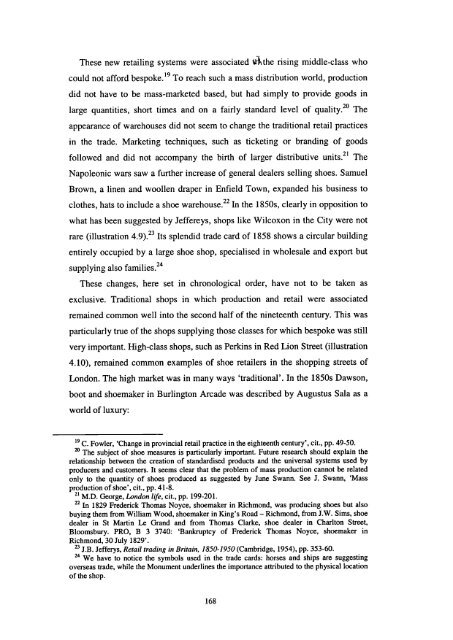The Boot and Shoe Trades in London and Paris in the Long Eighteenth Century
The Boot and Shoe Trades in London and Paris in the Long Eighteenth Century
The Boot and Shoe Trades in London and Paris in the Long Eighteenth Century
Create successful ePaper yourself
Turn your PDF publications into a flip-book with our unique Google optimized e-Paper software.
<strong>The</strong>se new retail<strong>in</strong>g systems were associated <strong>the</strong> ris<strong>in</strong>g middle-class who<br />
could not afford bespoke. 19 To reach such a mass distribution world, production<br />
did not have to be mass-marketed based, but had simply to provide goods <strong>in</strong><br />
large quantities, short times <strong>and</strong> on a fairly st<strong>and</strong>ard level of quality. 20 <strong>The</strong><br />
appearance of warehouses did not seem to change <strong>the</strong> traditional retail practices<br />
<strong>in</strong> <strong>the</strong> trade. Market<strong>in</strong>g techniques, such as ticket<strong>in</strong>g or br<strong>and</strong><strong>in</strong>g of goods<br />
followed <strong>and</strong> did not accompany <strong>the</strong> birth of larger distributive units. 21 <strong>The</strong><br />
Napoleonic wars saw a fur<strong>the</strong>r <strong>in</strong>crease of general dealers sell<strong>in</strong>g shoes. Samuel<br />
Brown, a l<strong>in</strong>en <strong>and</strong> woollen draper <strong>in</strong> Enfield Town, exp<strong>and</strong>ed his bus<strong>in</strong>ess to<br />
clo<strong>the</strong>s, hats to <strong>in</strong>clude a shoe warehouse. 22 In <strong>the</strong> 1850s, clearly <strong>in</strong> opposition to<br />
what has been suggested by Jeffereys, shops like Wilcoxon <strong>in</strong> <strong>the</strong> City were not<br />
rare (illustration 4•9)•23 Its splendid trade card of 1858 shows a circular build<strong>in</strong>g<br />
entirely occupied by a large shoe shop, specialised <strong>in</strong> wholesale <strong>and</strong> export but<br />
supply<strong>in</strong>g also families.24<br />
<strong>The</strong>se changes, here set <strong>in</strong> chronological order, have not to be taken as<br />
exclusive. Traditional shops <strong>in</strong> which production <strong>and</strong> retail were associated<br />
rema<strong>in</strong>ed common well <strong>in</strong>to <strong>the</strong> second half of <strong>the</strong> n<strong>in</strong>eteenth century. This was<br />
particularly true of <strong>the</strong> shops supply<strong>in</strong>g those classes for which bespoke was still<br />
very important. High-class shops, such as Perk<strong>in</strong>s <strong>in</strong> Red Lion Street (illustration<br />
4.10), rema<strong>in</strong>ed common examples of shoe retailers <strong>in</strong> <strong>the</strong> shopp<strong>in</strong>g streets of<br />
<strong>London</strong>. <strong>The</strong> high market was <strong>in</strong> many ways 'traditional'. In <strong>the</strong> 1850s Dawson,<br />
boot <strong>and</strong> shoemaker <strong>in</strong> Burl<strong>in</strong>gton Arcade was described by Augustus Sala as a<br />
world of luxury:<br />
' C. Fowler, 'Change <strong>in</strong> prov<strong>in</strong>cial retail practice <strong>in</strong> <strong>the</strong> eighteenth century', cit., pp. 49-50.<br />
20 <strong>The</strong> subject of shoe measures is particularly important. Future research should expla<strong>in</strong> <strong>the</strong><br />
relationship between <strong>the</strong> creation of st<strong>and</strong>ardised products <strong>and</strong> <strong>the</strong> universal systems used by<br />
producers <strong>and</strong> customers. It seems clear that <strong>the</strong> problem of mass production cannot be related<br />
only to <strong>the</strong> quantity of shoes produced as suggested by June Swann. See J. Swann, 'Mass<br />
production of shoe', cit., pp. 41-8.<br />
21 M.D. George, <strong>London</strong> life, cit., pp. 199-201.<br />
22 In 1829 Frederick Thomas Noyce, shoemaker <strong>in</strong> Richmond, was produc<strong>in</strong>g shoes but also<br />
buy<strong>in</strong>g <strong>the</strong>m from William Wood, shoemaker <strong>in</strong> K<strong>in</strong>g's Road - Richmond, from J.W. Sims, shoe<br />
dealer <strong>in</strong> St Mart<strong>in</strong> Le Gr<strong>and</strong> <strong>and</strong> from Thomas Clarke, shoe dealer <strong>in</strong> Charlton Street,<br />
Bloomsbury. PRO, B 3 3740: 'Bankruptcy of Frederick Thomas Noyce, shoemaker <strong>in</strong><br />
Richmond, 30 July 1829'.<br />
J.B. Jefferys, Retail trad<strong>in</strong>g <strong>in</strong> Brita<strong>in</strong>, 1 850-1 950 (Cambridge, 1954), pp. 353-60.<br />
We have to notice <strong>the</strong> symbols used <strong>in</strong> <strong>the</strong> trade cards: horses <strong>and</strong> ships are suggest<strong>in</strong>g<br />
overseas trade, while <strong>the</strong> Monument underl<strong>in</strong>es <strong>the</strong> importance attributed to <strong>the</strong> physical location<br />
of <strong>the</strong> shop.<br />
168


